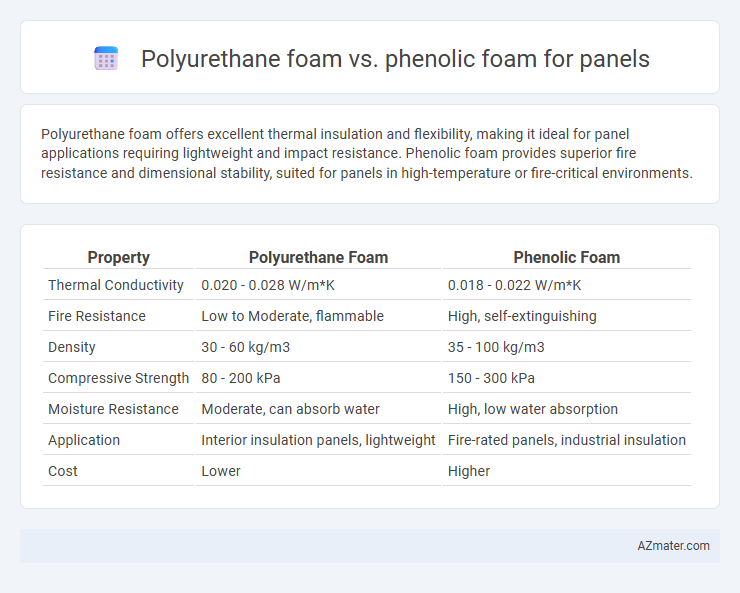Polyurethane foam offers excellent thermal insulation and flexibility, making it ideal for panel applications requiring lightweight and impact resistance. Phenolic foam provides superior fire resistance and dimensional stability, suited for panels in high-temperature or fire-critical environments.
Table of Comparison
| Property | Polyurethane Foam | Phenolic Foam |
|---|---|---|
| Thermal Conductivity | 0.020 - 0.028 W/m*K | 0.018 - 0.022 W/m*K |
| Fire Resistance | Low to Moderate, flammable | High, self-extinguishing |
| Density | 30 - 60 kg/m3 | 35 - 100 kg/m3 |
| Compressive Strength | 80 - 200 kPa | 150 - 300 kPa |
| Moisture Resistance | Moderate, can absorb water | High, low water absorption |
| Application | Interior insulation panels, lightweight | Fire-rated panels, industrial insulation |
| Cost | Lower | Higher |
Introduction to Polyurethane and Phenolic Foam Panels
Polyurethane foam panels are renowned for their excellent thermal insulation properties, high compressive strength, and versatility in construction applications. Phenolic foam panels offer superior fire resistance, low smoke emission, and high thermal stability, making them ideal for safety-critical environments. Both materials provide efficient insulation but differ significantly in fire performance and mechanical characteristics, influencing their choice in panel applications.
Composition and Manufacturing Process
Polyurethane foam is produced through the reaction of polyols and diisocyanates, resulting in a flexible or rigid polymer matrix with excellent insulation properties, commonly used in panel applications. Phenolic foam is synthesized by the polymerization of phenol and formaldehyde, forming a rigid, thermosetting resin with superior fire resistance and low smoke emission. Manufacturing polyurethane foam involves a liquid molding process with blowing agents to create cellular structure, whereas phenolic foam uses a foaming and curing process that yields a closed-cell, dimensionally stable panel core.
Thermal Insulation Performance Comparison
Polyurethane foam exhibits superior thermal insulation performance with lower thermal conductivity values, typically around 0.020-0.025 W/m*K, compared to phenolic foam, which ranges from 0.025-0.035 W/m*K. The closed-cell structure of polyurethane foam ensures enhanced resistance to heat transfer and higher R-values per inch, making it more effective for energy-efficient building panels. Phenolic foam, while offering fire resistance and dimensional stability, generally delivers slightly higher thermal conductivity, resulting in marginally lower insulation efficiency than polyurethane foam panels.
Fire Resistance and Safety Analysis
Phenolic foam exhibits superior fire resistance compared to polyurethane foam, boasting a higher char yield and lower heat release rate, which significantly reduces the risk of combustion and toxic gas emissions during a fire. Its inherent intumescent properties create a protective barrier, enhancing safety in panel applications by slowing down flame spread and improving structural integrity under high temperatures. Polyurethane foam, while lightweight and insulative, tends to ignite more readily and produce denser smoke, making phenolic foam the preferred choice for fire-resistant and safety-critical panel installations.
Mechanical Strength and Durability
Polyurethane foam offers superior mechanical strength with higher compressive and tensile resistance, making it ideal for structural panels requiring durability under stress. Phenolic foam, while having lower mechanical strength, excels in thermal stability and fire resistance but tends to be more brittle, affecting long-term durability in dynamic load environments. For applications prioritizing mechanical performance and durability, polyurethane foam panels provide enhanced resilience and lifespan compared to phenolic foam counterparts.
Moisture and Water Resistance
Polyurethane foam offers moderate moisture resistance, making it suitable for environments with occasional exposure to humidity but less effective against prolonged water contact. Phenolic foam exhibits superior water resistance and low water absorption rates, providing enhanced protection in high-moisture or wet conditions. This makes phenolic foam panels ideal for applications requiring stringent moisture control and durability.
Weight and Structural Implications
Polyurethane foam panels typically offer lower weight compared to phenolic foam, enhancing ease of handling and reducing structural load. Phenolic foam exhibits superior fire resistance and dimensional stability, but its increased density can affect overall panel weight and structural design requirements. Balancing the lightweight advantage of polyurethane with the robust thermal and fire performance of phenolic foam is crucial for optimized panel application.
Environmental Impact and Sustainability
Polyurethane foam panels typically have a higher global warming potential due to their use of petrochemical-based ingredients and blowing agents with greenhouse gas emissions, whereas phenolic foam panels are generally considered more environmentally friendly because they contain lower volatile organic compounds (VOCs) and offer better fire resistance without harmful halogens. Phenolic foam's closed-cell structure enhances thermal insulation, reducing energy consumption in buildings and contributing to sustainability goals by lowering carbon footprint over the product lifecycle. Sustainable insulation choices increasingly favor phenolic foam for its ability to balance performance with reduced environmental impact and improved recyclability compared to polyurethane foam.
Cost Analysis and Economic Considerations
Polyurethane foam typically offers lower initial costs compared to phenolic foam, making it a cost-effective choice for panel insulation in budget-sensitive projects. Phenolic foam, despite its higher price point, provides superior fire resistance and thermal performance, potentially reducing long-term operational costs through enhanced energy efficiency and improved safety compliance. Economic considerations must weigh the balance between upfront investment and lifecycle savings, with polyurethane foam favored for lower-cost applications and phenolic foam justified in scenarios demanding stringent fire safety standards and durability.
Best Applications: Choosing the Right Foam Panel
Polyurethane foam panels excel in insulation for residential and commercial buildings due to their high R-value and superior moisture resistance, making them ideal for walls, roofs, and refrigerated storage. Phenolic foam panels offer exceptional fire resistance and low smoke emission, preferred in public buildings and transportation sectors where strict fire safety standards are mandatory. Selecting the right foam panel depends on prioritizing application-specific needs like thermal performance, fire safety, and environmental resistance.

Infographic: Polyurethane foam vs Phenolic foam for Panel
 azmater.com
azmater.com